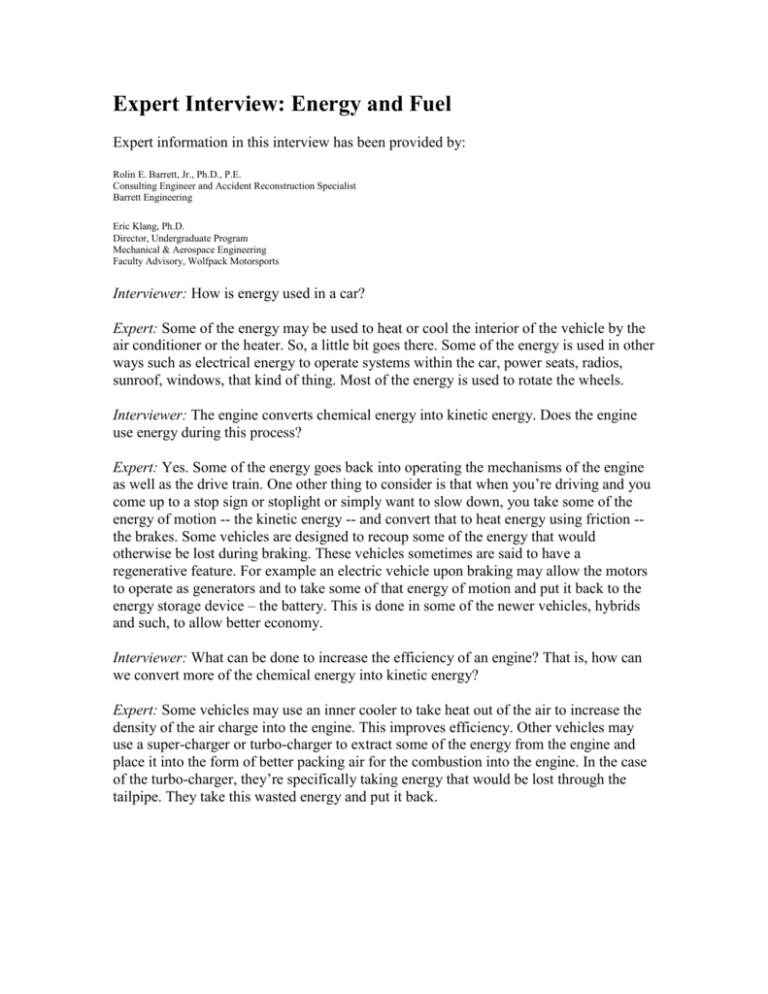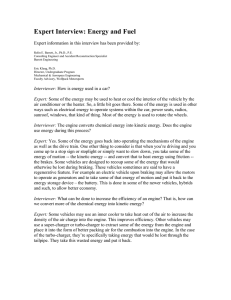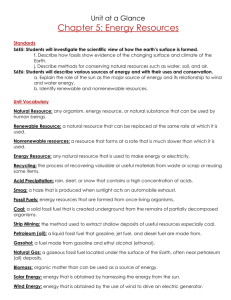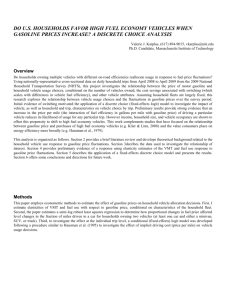Expert Interview: Egg Transport Vehicle
advertisement

Expert Interview: Energy and Fuel Expert information in this interview has been provided by: Rolin E. Barrett, Jr., Ph.D., P.E. Consulting Engineer and Accident Reconstruction Specialist Barrett Engineering Eric Klang, Ph.D. Director, Undergraduate Program Mechanical & Aerospace Engineering Faculty Advisory, Wolfpack Motorsports Interviewer: How is energy used in a car? Expert: Some of the energy may be used to heat or cool the interior of the vehicle by the air conditioner or the heater. So, a little bit goes there. Some of the energy is used in other ways such as electrical energy to operate systems within the car, power seats, radios, sunroof, windows, that kind of thing. Most of the energy is used to rotate the wheels. Interviewer: The engine converts chemical energy into kinetic energy. Does the engine use energy during this process? Expert: Yes. Some of the energy goes back into operating the mechanisms of the engine as well as the drive train. One other thing to consider is that when you’re driving and you come up to a stop sign or stoplight or simply want to slow down, you take some of the energy of motion -- the kinetic energy -- and convert that to heat energy using friction -the brakes. Some vehicles are designed to recoup some of the energy that would otherwise be lost during braking. These vehicles sometimes are said to have a regenerative feature. For example an electric vehicle upon braking may allow the motors to operate as generators and to take some of that energy of motion and put it back to the energy storage device – the battery. This is done in some of the newer vehicles, hybrids and such, to allow better economy. Interviewer: What can be done to increase the efficiency of an engine? That is, how can we convert more of the chemical energy into kinetic energy? Expert: Some vehicles may use an inner cooler to take heat out of the air to increase the density of the air charge into the engine. This improves efficiency. Other vehicles may use a super-charger or turbo-charger to extract some of the energy from the engine and place it into the form of better packing air for the combustion into the engine. In the case of the turbo-charger, they’re specifically taking energy that would be lost through the tailpipe. They take this wasted energy and put it back. There’s another type of device which is similar to a turbo-charger and is sometimes called a scavenger. That’s a slang term. But this device is basically like half of a turbocharger with the shaft. It takes some of that energy from the exhaust and mechanically returns it. We hear a lot of stories over the years about the miracle carburetor or miracle fuel injection system or some special engine that will somehow allow the vehicle to attain this wonderful mileage. Usually the stories tell of some vehicle that will get 300 miles to the gallon or something such as this. If someone could invent this they would be very wealthy! The reality is there’s only so much air you can extract from our fuels. Gasoline only holds so much energy per gallon. The same is true with diesel fuel. They have a limited amount of energy. And engineers do strive to extract as much as possible. But there’s no great conspiracy to hide the use of energy. Interviewer: Describe design factors that enhance speed versus design factors that enhance distance. Expert: Dragsters may be fun but it’s hard to go to the beach or take your groceries home in them. So we know that design factors definitely will allow a vehicle to be fast or achieve great distance. And we can see that in cars currently available. A high performance sports car offers the potential for great speed. Family cars and vans offer better mileage. We have to be careful though when we strive to design something that is a master of all situations because frequently the compromise will give a vehicle that will do none of these very well. So we want to focus on the areas that are important to us. If it happens to be speed or distance then we need to focus on one and not focus so much on the other. Interviewer: Several types of fuel are available. One general distinction is the nature of the fuel – solid, liquid, or gas. Please discus the pros and cons of some examples. Expert: Solid fuels are considered more stable than liquid fuels. Solid fuel vehicles have been produced. Examples include wood-burning trains which were used up until the nineteenth century and coal-burning trains that were used later, well into the twentieth century. And there have been some experimental cars that used a very finely powdered coal. They powdered the coal to make it more than coal. And they were able to move it through the fuel system. But these have never achieved commercial success. We use gasoline because it’s fairly cheap. Additionally the infrastructure is in place for gasoline, which is a huge savings. Look at going to hydrogen. The infrastructure is a real concern. NASA has invested a significant amount of money to build the infrastructure to support their hydrogenpowered rockets. Somewhat simpler are solid propellant rockets. But solid fuels have drawbacks too. Not all solid fuels are more stable than common liquid fuels. For example black powder, which is a sulfur and potassium nitrate compound, was commonly used by cannons and some firearms up through the twentyfirst century, and is still in use in some specialized applications by militaries around the world. But black powder is definitely not as stable as gasoline. If I take some gasoline and shake it or hit it, I’m not going to have a problem. But if I hit a small pile of black powder with a hammer, bad things can happen. Solid fuels are also more difficult to transport throughout the vehicle. The vehicle’s fuel storage, the gas tank, the fuel lines, fuel pump, and carburetor or injectors from a fairly simple and dependable system of fuel distribution to the engine. Some engines had been built using powdered solid fuels, but they’re not in common use. Liquid fuels are just easier to use -- just much more convenient. It’s also a little hard to turn off that bottle rocket of a car at a stoplight. Once solid rockets are lit they tend to turn until the fuel is gone.











